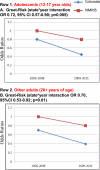Temporal trends in marijuana attitudes, availability and use in Colorado compared to non-medical marijuana states: 2003-11
- PMID: 24837585
- PMCID: PMC4161452
- DOI: 10.1016/j.drugalcdep.2014.04.016
Temporal trends in marijuana attitudes, availability and use in Colorado compared to non-medical marijuana states: 2003-11
Abstract
Background: In 2009, policy changes were accompanied by a rapid increase in the number of medical marijuana cardholders in Colorado. Little published epidemiological work has tracked changes in the state around this time.
Methods: Using the National Survey on Drug Use and Health, we tested for temporal changes in marijuana attitudes and marijuana-use-related outcomes in Colorado (2003-11) and differences within-year between Colorado and thirty-four non-medical-marijuana states (NMMS). Using regression analyses, we further tested whether patterns seen in Colorado prior to (2006-8) and during (2009-11) marijuana commercialization differed from patterns in NMMS while controlling for demographics.
Results: Within Colorado those reporting "great-risk" to using marijuana 1-2 times/week dropped significantly in all age groups studied between 2007-8 and 2010-11 (e.g. from 45% to 31% among those 26 years and older; p=0.0006). By 2010-11 past-year marijuana abuse/dependence had become more prevalent in Colorado for 12-17 year olds (5% in Colorado, 3% in NMMS; p=0.03) and 18-25 year olds (9% vs. 5%; p=0.02). Regressions demonstrated significantly greater reductions in perceived risk (12-17 year olds, p=0.005; those 26 years and older, p=0.01), and trend for difference in changes in availability among those 26 years and older and marijuana abuse/dependence among 12-17 year olds in Colorado compared to NMMS in more recent years (2009-11 vs. 2006-8).
Conclusions: Our results show that commercialization of marijuana in Colorado has been associated with lower risk perception. Evidence is suggestive for marijuana abuse/dependence. Analyses including subsequent years 2012+ once available, will help determine whether such changes represent momentary vs. sustained effects.
Keywords: Cannabis; Decriminalization; Legalized marijuana; Marijuana policy; Medical marijuana.
Copyright © 2014 Elsevier Ireland Ltd. All rights reserved.
Figures



References
-
- Anderson DM, Hansen B, Rees DI. Medical marijuana laws, traffic fatalities, and alcohol consumption. J. Law Econ. 2013;56:333–369.
-
- Bachman JG, Johnston LD, O'Malley PM. Explaining the recent decline in cocaine use among young adults: further evidence that perceived risks and disapproval lead to reduced drug use. J. Health Soc. Behav. 1990;31:173–184. - PubMed
-
- Bowles DW. Persons registered for medical marijuana in the United States. J. Palliat. Med. 2012;15:9–11. - PubMed
-
- CDPHE (Colorado Department of Public Health and Environment) [December 19th, 2012];2012 http://www.colorado.gov/cs/Satellite/CDPHE-CHEIS/CBON/1251607792088.
-
- Census [July 10, 2012];2010 http://quickfacts.census.gov/qfd/states/08000.html.
Publication types
MeSH terms
Substances
Grants and funding
LinkOut - more resources
Full Text Sources
Other Literature Sources
Medical
Molecular Biology Databases
Miscellaneous

